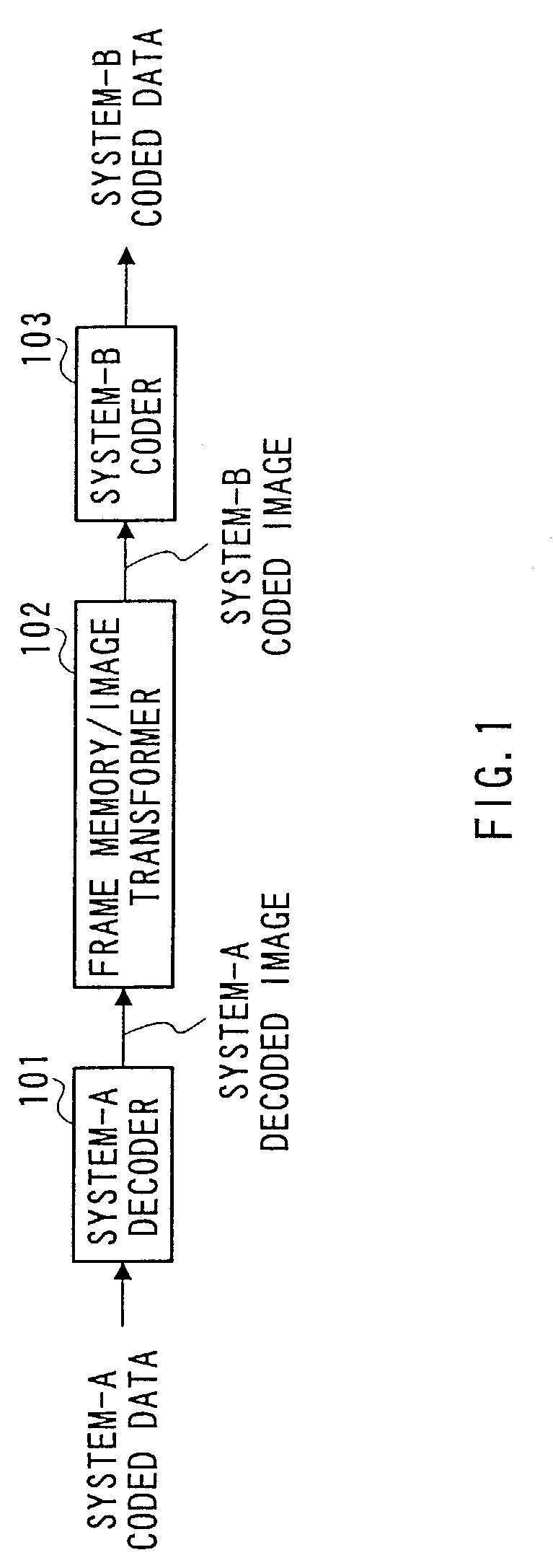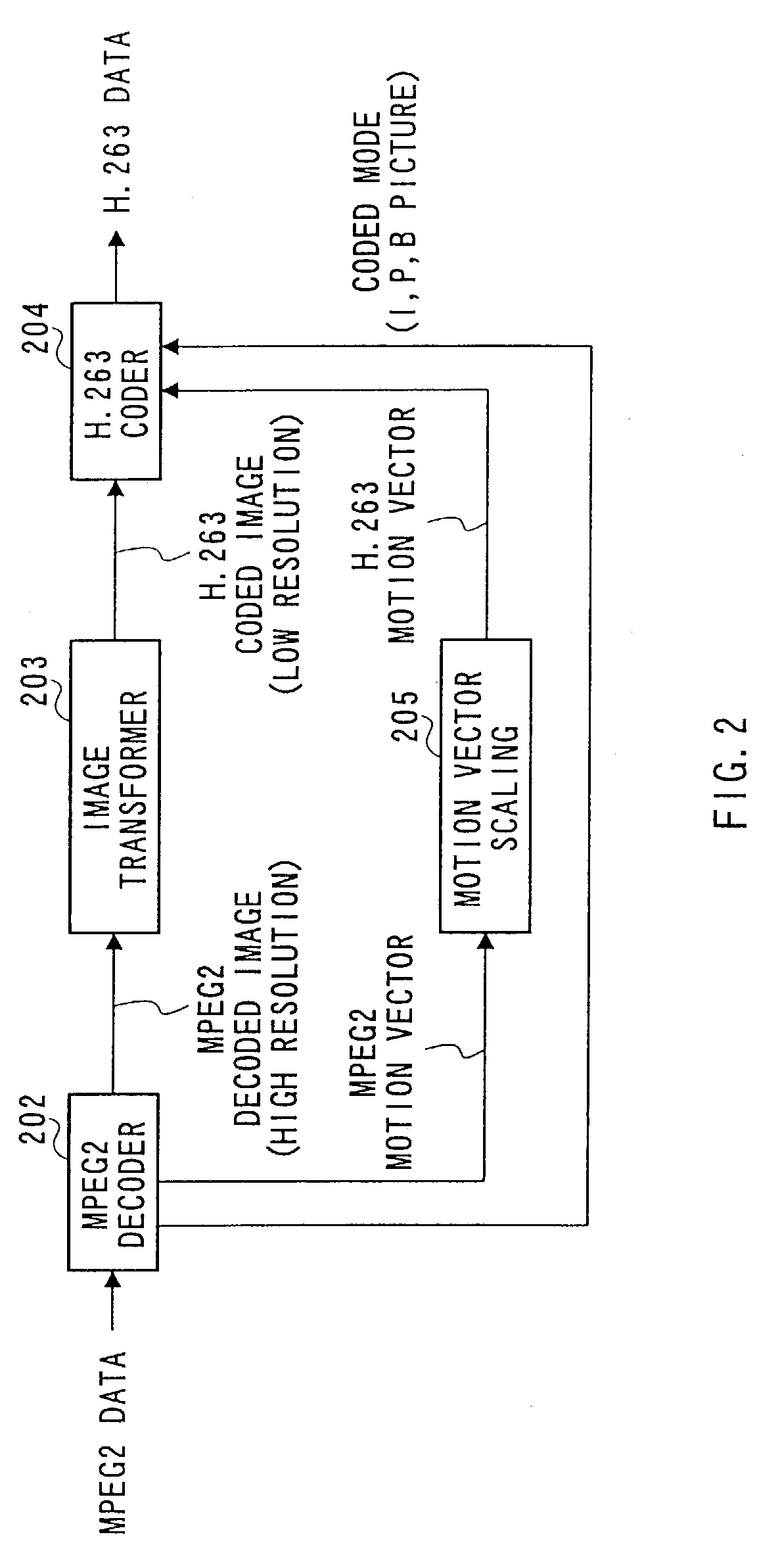Method and apparatus for transforming moving picture coding system
- Summary
- Abstract
- Description
- Claims
- Application Information
AI Technical Summary
Benefits of technology
Problems solved by technology
Method used
Image
Examples
first embodiment
[0125]In the first embodiment, the transformation based on flowcharts illustrated in FIGS. 9 to 11 is performed. Among process steps enclosed with bold lines in FIG. 9, the intra-inter coding mode control (S1) is performed according to the flowchart illustrated in FIG. 10, and change of coding data on a macroblock-by-macroblock basis for the rate control (S2) is performed according to the flowchart illustrated in FIG. 11.
[0126]Herein, it is assumed that, as conditions for the rate control, a coding rate of H.261 is 64 kbps, a coding rate of MPEG-4 is also 64 kbps, and that a buffer size of the output buffer is 6.4 kbit.
[0127]In the intra-inter coding mode control illustrated in FIG. 10, when the H.261 data sequence is transformed to the MPEG-4 data sequence, the predetermined number (3 in this embodiment) of macro blocks are selected from macro blocks belonging a moving region in descending order of refreshing period, and the coding mode of the selected macro blocks are forcedly cha...
second embodiment
[0148]The second embodiment is next described.
[0149]The second embodiment describes the transformation method from MPEG-4 to H.261. The transformation operations in this embodiment are performed based on flowcharts illustrated in FIGS. 9, 12 and 13.
[0150]Among processing steps enclosed with bold lines, the intra-inter coding mode control is performed according to the flowchart in FIG. 12, and the change of coding data on a macroblock-by-macroblock for the rate control is performed according to the flowchart in FIG. 13.
[0151]The difference of this embodiment from the first embodiment is mainly explained to simplify the explanation.
[0152]Herein, it is assumed that macro blocks more than needed are intra-coded to improve the error resistance although the coding efficiency of MPEG-4 is higher than that of H.261.
[0153]In the control for the intra-inter coding mode illustrated in FIG. 12, coding modes of intra-coded macro blocks are set at ‘U’ (unfixed) except macro block with the maximum...
fourth embodiment
[0164]A fourth embodiment is next explained with FIG. 16.
[0165]An apparatus of the fourth embodiment performs the transformation from MPEG-4 to H.261, inversely to the apparatus of the third embodiment. In FIG. 16, 601 is a variable length decoding section, 602 is an inverse quantization section, 603 is an inverse DCT section, 604 is an adder, 605 is a frame memory, and 606 is a motion compensation section, thus composing a MPEG-4 decoder.
[0166]A decoded image is provided to an H.261 coder through frame memory 605.
[0167]607 is a subtracter, 608 is a DCT section, 609 is a quantization section, 610 is an inverse quantization section, 611 is an inverse quantization section, 612 is an adder, 613 is a frame memory, 614 is a motion prediction and motion compensation section, 615 is a loop filter, 616 is a variable length coding section, and 617 is an output buffer, thus composing the H.261 coder. 618 is an H.261 rate control section, and achieves the control described in FIGS. 9, 12 and 1...
PUM
 Login to View More
Login to View More Abstract
Description
Claims
Application Information
 Login to View More
Login to View More - R&D
- Intellectual Property
- Life Sciences
- Materials
- Tech Scout
- Unparalleled Data Quality
- Higher Quality Content
- 60% Fewer Hallucinations
Browse by: Latest US Patents, China's latest patents, Technical Efficacy Thesaurus, Application Domain, Technology Topic, Popular Technical Reports.
© 2025 PatSnap. All rights reserved.Legal|Privacy policy|Modern Slavery Act Transparency Statement|Sitemap|About US| Contact US: help@patsnap.com



